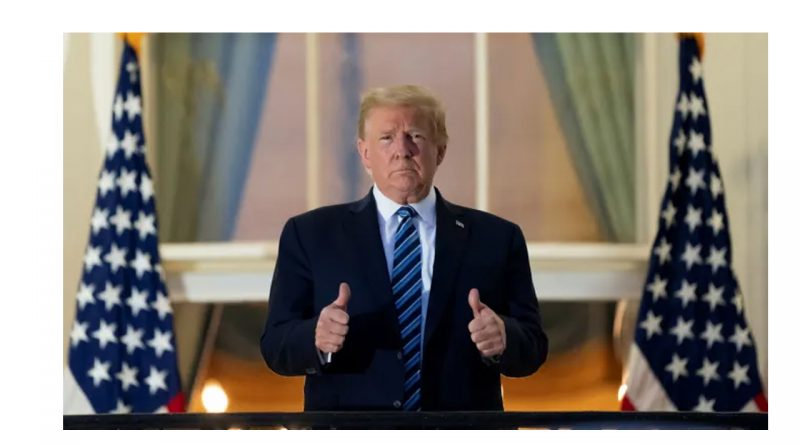Trump regresó a la Casa Blanca tras tres días hospitalizado por covid-19
El presidente de Estados Unidos, Donald Trump, recibió el alta médica este lunes en horas de la tarde, luego de permanecer tres días hospitalizado por covid-19 en el hospital militar Walter Reed, en Bethesda (Maryland), pese a que su médico personal, Sean Conley, reconoció que «no está fuera de peligro».
Trump abandonó el centro de salud caminando, para montarse en el vehículo que lo llevó al helicóptero presidencial Marine One, que le trasladó de vuelta a la Casa Blanca.
Minutos antes escribió en su cuenta en Twitter: «Nos vemos pronto en la campaña».
Al llegar a la Casa Blanca, subió las escaleras, se quitó la mascarilla y saludó la partida del Marine One. Segundos después, el mandatario entró sin mascarilla al interior del edificio.
En horas de la tarde del lunes, Sean Conley, médico personal del presidente estadounidense, Donald Trump, reconoció que el mandatario «no está fuera de peligro», y que se encuentra de hecho en un «terreno no explorado» por otros pacientes.
En una rueda de prensa poco después de que Trump anunciara que volverá a la Casa Blanca este lunes, Conley defendió la decisión de darle el alta hospitalaria al presidente después de solo tres días ingresado, en los que ha experimentado al menos dos bajadas de oxígeno.

Donald Trump returns to White House after three days in hospital
Doctor warns president not yet ‘out of the woods’ as more aides diagnosed with Covid-19
Donald Trump returned to the White House on Monday evening after three days of hospital treatment for coronavirus, although his doctor warned that the president was not yet “out of the woods”.
Mr Trump walked down the steps of the Walter Reed Medical Center wearing a mask and without assistance shortly before 7pm, giving a thumbs up to the cameras and saying only: “Thank you very much, everybody.”
Upon returning to the White House, he discarded his mask for an extended period to watch the departure of the presidential helicopter, Marine One, which had flown him back from the Maryland military hospital.
Mr Trump’s return ended a day in which he declared himself “feeling really good” and returned to Twitter to downplay the outbreak’s severity.
“Don’t be afraid of Covid. Don’t let it dominate your life,” he wrote just before departing Walter Reed. “We have developed, under the Trump administration, some really great drugs and knowledge. I feel better than I did 20 years ago!”
Despite his upbeat pronouncements, Mr Trump left Walter Reed as the virus continued to spread within his inner circle and with the White House struggling to respond to questions about his illness, such as when he contracted the disease and the results of X-rays and scans.
Kayleigh McEnany, the White House press secretary, said on Monday that she had tested positive for the virus, though she insisted she was “experiencing no symptoms”. She added that she would begin to quarantine immediately.
Sean Conley, the president’s personal physician, said just before Mr Trump’s departure from the hospital that the president’s fever had abated and his oxygen levels had returned to normal, having twice dropped to concerning levels since Friday.
Dr Conley said: “Though he may not entirely be out of the woods yet, the team and I agree that all our evaluations and, most importantly, his clinical status support the president’s safe return home, where he’ll be surrounded by world class medical care, 24/7.”
Asked if Mr Trump’s mental clarity had been affected by the cocktail of drugs he is on, Dr Conley said: “You’ve seen the videos and other tweets and you’ll see him shortly . . . he’s back.” He declined to discuss whether diagnostic tests had shown any damage to the president’s lungs, which has been the case with many coronavirus patients.
After the second episode of falling blood oxygen levels, which occurred while he was at Walter Reed, Mr Trump’s doctors administered an anti-inflammatory steroid called dexamethasone.
The World Health Organization recommends the drug for patients with “severe” Covid-19, while the US National Institutes of Health recommends it for patients who require artificial ventilation or supplemental oxygen. By Demetri Sevastopulo and Kiran Stacey


Debe estar conectado para enviar un comentario.